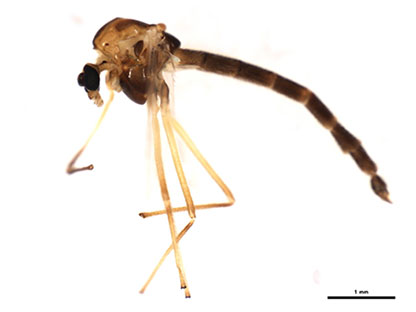Species f. C. riparius-group
In BOLD Bin: BOLD:AAM6285
Adult:
 Some data on the adults can be obtained from photographs in the BOLD database.
Male -
Some data on the adults can be obtained from photographs in the BOLD database.
Male -
Antennae are not available, fore tarsi are not available,
so AR, LR and BR are not known.
Thorax yellow, with vittae, etc., brown.
Wing length about 3.35 mm.
Femur and tibia yellowish, but with dark knees.
Leg proportions (approximate) (micron):
|
Fe
|
Ti
|
F/T
|
PI
|
1300
|
1050
|
1.24
|
PII
|
1370
|
1275
|
1.07
|
PIII
|
1660
|
1535
|
1.0
|
Abdominal tergites dark brown, with just a narrow distal stripe on segments III-VII.
The two photographs available are for east Canadian specimens.
Female
.jpg)
Darker than the male, thorax yellowish brown, vittae dark brown.
Wing length about 4.7 mm, width about 0.83 mm, VR abt 1.08.
Antennae approx. (micron) 170 : 113 : 127 : 127 : 268. AR about 0.5; A5/A1 about 1.58.
Fore tarsi are not available, so LR is not known.
Legs with anterior half yellow, then darkenning, and tibiae and tarsi brown.
Leg proportions (approximate) (micron)
|
Fe
|
Ti
|
Ta1
|
Ta2
|
Ta3
|
PI
|
1500
|
1278
|
2115
|
750
|
610
|
PII
|
1375
|
1330
|
685
|
375
|
250
|
PIII
|
1665
|
1750
|
1250
|
790
|
520
|
|
Ta4
|
Ta5
|
LR
|
F/T
|
BR
|
PI
|
330
|
165
|
1.65
|
1.17
|
-
|
PII
|
186
|
125
|
0.52
|
1.03
|
-
|
PIII
|
290
|
187
|
0.71
|
0.95
|
-
|
Abdomen dark brown.
This Quebec female appears to be somewhat larger than the available males.
Pupa: not known.
Larva of the plumosus-type, length about 10.5-16 mm; ventral tubules quite long, anterior pair possibly longer (ant. 1.72 mm; post. 1.60 mm.). Anal tubules quite long with a constriction about 1/3 from base, ventral pair slightly longer, 4.3-5.2 times longer than wide (520-620 x 120 µm).
Gula slightly darkened on posterior third; frontoclypeus pale or slightly darkened, sometimes with stripes outside parallel to the margins.
Mentum (Fig. c) with teeth pointed, c1 tooth with square sides, c2 teeth well separated (type III-IV); 4th laterals slightly reduced (type I-II).
Ventromentum (Fig. d) about 3.6 times longer than deep, with about 39-40 striae, VMR about 0.33-0.41. Pecten epipharyngis (Fig. a) with about 14 sharp but irregular teeth (type C variant).
Antenna (Fig. b) with basal segment about 4 times as long as wide; AR about 2. Mandible (Fig. e) with third inner tooth pale but separated (type II). Anal tubules quite long.
Cytology: 4 polytene chromosomes with thummi arm combination AB, CD, EF, G, but Keyl pattern hard to recognise.
Arm G mostly paired although ends may be unpaired and uneven; median Balbiani ring (BR).
Nucleoli in arms A and D, BR in arm E. Polymorphism in arm G, and possibly also for nucleolus in arm A.
Arm A1: Nucleolus near bands 4-6, making pattern hard to identify.
Arm B1: Bulb, with proximal dark bands (groups 8-7), almost terminal.
Arm C1: Groups 3-4 proximal of center of arm.
Arm D1: Nucleolus median in arm.
Arm E1: 1 - 3e, 5 - 10b, 4 - 3f, 10c - 13 ie. as aberratus, sp. a, etc. BR about 10ab.
Arm F1: 1a-d, ? - ?, 7 - 9, 2 - 1e, 16 - 17, 11 - 14?, 6 - 4? 19?, 23 - 20
Arm G1: Approximately median BR.
Arm G2: Inversion of most of the arm (see figure).
Molecular Data: Sequence for mitochondrial COI is available in the BOLD Database.
Found: New Brunswick - Grand Bay-Westrfield (from BOLD); Kouchibouguac Natl. Pk. (from BOLD).
Newfoundland & Labrador - Terra Nova N.P., Newman Sound (48.543°N, 53.978°W)(BOLD).
Nova Scotia - Cape Breton Highland Natl. Pk. (from BOLD); Kejimkujik Natl. Pk. (from BOLD).
Ontario - 2 ml. s. & w. Clarence Creek, Russell Co.(45.50°N, 75.22°W),; Barron Creek, nr. Squirrel Rapids (45.87°N, 77.90°W),
Algonquin Provincial Park.
Quebec - King Mt. (45.43°;N, 75.73°W), Gatineaus; La Maurice Natl. Pk. (from BOLD).
Snow melt pools and other small pools.
See also C. riparius and C. sp. 2c,
[ Return to Index ]
|

.jpg)